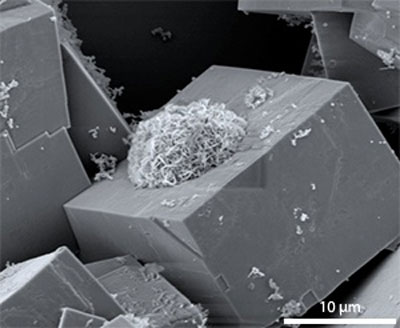| Jun 13, 2011 |
Seeding method allows functionalized metal-organic frameworks to be grown rapidly with precise structural control
|
|
(Nanowerk News) Metal-organic frameworks (MOFs) are highly porous, ordered networks consisting of inorganic centers linked by organic moieties. Their large surface areas make them attractive for various uses including catalysis, gas storage, and as filtration and purification membranes. Such industrial applications, however, require large-scale, well-controlled synthetic routes, which for MOFs have proved difficult to achieve. Dario Buso and Paolo Falcaro from the CSIRO in Australia have now led a group of researchers in developing a seeding method that can trigger MOF formation in a spatially controlled way whilst simultaneously allowing functionalization of the framework ("A new method to position and functionalize metal-organic framework crystals").
|
 |
| Scanning electron microscopy image of DRMs nucleating the growth of MOF crystals.
|
|
The researchers used microparticles of nanostructured poly-hydrate zinc phosphate as seeds to nucleate the growth of a crystalline MOF in solution and on solid surfaces. "We can use these seeds in a variety of ways," says Buso. "We can use them to induce MOF formation on complex surface geometries or arbitrary supports, which are both essential for device fabrication."
|
|
The researchers have named their seeds 'desert rose microparticles' (DRMs) because of their resemblance to the desert rose mineral. The use of DRMs allows MOF crystals (see image) to be produced at accelerated crystal growth rates, and the use of patterned substrates prepared by lithographic techniques allows precise control of the position of the DRMs — and hence the structure of the MOF.
|
|
Functional MOF composites can be prepared by embedding nanoparticles of metals, semiconductors or polymeric nanoparticles inside the DRMs prior to nucleation of the framework composite. This locates the nanoparticles directly within the core of the structure, rather than in the framework matrix or on the external surface. Buso and his colleagues demonstrated this procedure by perfectly encapsulating quantum dots within the MOF to afford a structure that could be used as a molecular sieve sensor.
|
|
"We can easily foresee several technological areas that could utilize devices based on MOF composites," says Falcaro. "Such devices will exploit the mutual advantages of the intrinsic performance of MOFs in selectively controlling diffusion dynamics with the ability to encapsulate functional species that can respond to a trigger. Such a trigger could be the selective diffusion of molecules that bind with the functional species resulting in a signal or chemical reaction."
|

